Flabellidae
Stephen D. Cairns- Flabellum
- Truncatoflabellum
- Blastotrochus
- Placotrochus
- Javania
- Placotrochides
- Falcatoflabellum
- Monomyces
- Rhizotrochus
- Polymyces
- Conosmilia

- Adkinsella

Introduction
The flabellids are known from the Early Cretaceous (about 135 million years ago) to the Recent, and are widespread in today's oceans from the North Sea to continental Antarctica. They range from depths from 0 to 3200 meters and from temperatures of -1°C (continental Antarctica) to the tropics. They are exclusively azooxanthellate. Flabellids range in size from the small Falcatoflabellum, which is only 3 mm in greater diameter and 10 mm in height, to Flabellum impensum, which is one of the largest solitary Scleractinia, measuring up to 128 mm in greater calicular diameter and 80 mm in height. One hundred three Recent species are known in 11 genera, most of these (73) occurring in two speciose genera: Flabellum and Truncatoflabellum, and the rate of description of new species shows no decline (Cairns et al., 1999). The flabellids are better represented in the fossil record, there being almost twice as many fossil species as Recent (Cairns, 1989a).

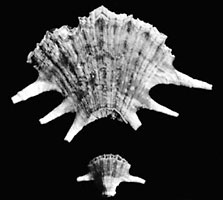
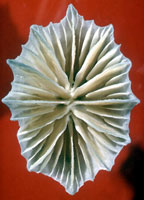
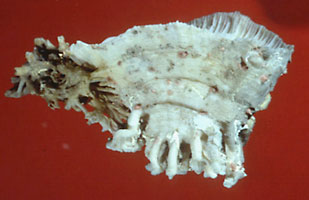
Left (top): Truncatoflabellum candeanum: The neotype specimen, including both anthocaulus (basal) and anthocyathus (distal) stages, collected from the Philippines (depth 194 m). Greater calicular diameter 18 mm (from Cairns, 1989a). Middle: Flabellum apertum: Calicular view of a skeleton collected from the Macquarie Ridge (depth 1647 m), an example of a free-living flabellid. Greater calicular diameter 27 mm. Copyright © 2002 S. D. Cairns. Right (bottom): Rhizotrochus typus: Side view of a skeleton collected from the Philippines (depth 124 m). This genus is characterized by tubular hollow basal rootlets that help attach the coral to the substrate. Height of corallum 43 mm. Copyright © 2002 S. D. Cairns
Flabellids are exclusively solitary in growth form -- never forming colonies -- but certain genera reproduce asexually by transverse division (Cairns, 1989b) and budding from the thecal edge. The corallum of many flabellids is fan-shaped, as implied by the root of its name (flabellum, Latin for a small fan), having a calice elliptical in cross section. There are as many attached as free living forms, the former sometimes attached by contiguous or noncontiguous, hollow rootlets. The coralla of those genera characterized by transverse division usually bear several pairs of thecal edge spines that do not reach the substrate. Some genera are hosts for the galls of ascothoracidan Crustacea (Grygier and Zibrowius, 1985), and one genus, Javania, is the host of the burrows of acrothoracican cirripeds (Cairns and Zibrowius, 1997).
Some other publications that include significant information regarding flabellids are: Cairns (1994), Gardiner (1902), Squires (1962, 1963, 1964), and Yabe and Eguchi (1942).
Characteristics
Flabellids are characterized by having a smooth, often porcellaneous marginotheca devoid of the pits or pores that characterize the Guyniidae. They also differ from the guyniids in general, by having larger coralla with more septa (up to 300) and flabellate vs circular calices, and in lacking pali.
Discussion of Phylogenetic Relationships
No phylogenetic analysis has been made of the flabellid genera. The most modern comprehensive accounts of the family are those of Zibrowius (1974) and Cairns (1989a), both of whom provide tabular keys to the genera. Characters considered to be important in discriminating genera are: type of columella, type of basal fixation, presence or absence of transverse division, and nature of the calicular edge. Recent work by Stolarski (1995, 2000) on wall microstructure may lead to a reorganization of the taxa within this family. The monophyly of the family is supported by preliminary molecular analysis (Romano and Cairns, 2000) using 16S mtDNA sequencing, which places the three flabellid genera tested in the same clade.
References
Cairns, S. D. 1982. Antarctic and Subantarctic Scleractinia. Antarctic Research Series, 34: 1-74.
Cairns, S. D. 1989a. A revision of the ahermatypic Scleractinia of the Philippine Islands and adjacent waters, Part 1: Fungiacyathidae, Micrabaciidae, Turbinoliinae, Guyniidae, and Flabellidae. Smithsonian Contributions to Zoology, 486: 136 pp.
Cairns, S. D. 1989b. Asexual reproduction in solitary Scleractinia. Proceedings of the 6th International Coral Reef Symposium, Australia, 2: 641-646.
Cairns, S. D. 1994. Scleractinia of the temperate North Pacific. Smithsonian Contributions to Zoology, 557: 150 pp.
Cairns, S. D. 1995. The marine fauna of New Zealand: Scleractinia (Cnidaria: Anthozoa). New Zealand Oceanographic Institute Memoir, 103: 210 pp.
Cairns, S. D., B. W. Hoeksema, and J. van der Land. 1999. Appendix: List of Extant Stony Corals. Atoll Research Bulletin, 459: 13-46.
Cairns, S. D. and H. Zibrowius. 1997. Cnidaria, Anthozoa: Azooxanthellate Scleractinia from the Philippine and Indonesian regions. Mémoires du Muséum d'Histoire Naturelle, 172: 27-243.
Gardiner, J. S. 1902. South African corals of the genus Flabellum, with an account of their anatomy and development. Marine Investigations of South Africa, 2(6): 115-154.
Grygier, M. J. and H. Zibrowius. 1985. Diversity and range of scleractinian coral hosts of Ascothoracida (Crustacea: Maxillopoda). Annals d l'Institut Océanographique, paris, 61(2): 115-138.
Romano S. L. and S. D. Cairns. 2000. Molecular Phylogenetic Hypotheses from the Evolution of Scleractinian Corals. Bulletin of Marine Science, 67(3): 1043-1068.
Squires, D. F. 1962. Deep sea corals collected by Lamont Geological Observatory. 3. Larvae of the argentine scleractinian coral Flabellum curvatum Moseley. American Museum Novitates, 2078: 11 pp.
Squires, D. F. 1963. Flabellum rubrum (Quoy and Gaimard). New Zealand Oceanographic Institute Memoir, 20: 43 pp.
Squires, D. F. 1964. Biological results of the Chatham Islands 1954 expedition. Part 6: Scleractinia. New Zealand Oceanographic Institute, Memoir 29: 29 pp.
Stolarski, J. 1995. Ontogenetic development of the thecal structures in caryophylliine scleractinian corals. Acta Paleontologica Polonica, 40: 19-44.
Stolarski, J. 1996. Gardineria - a scleractinian living fossil. Acta Palaeontologica, 41(4): 339-367.
Stolarski, J. 2000. Origin and phylogeny of Guyniidae (Scleractinia) in the light of microstructural data. Lethaia, 33: 13-38.
Vaughan, T. W. and J. W. Wells. 1943. Revision of the suborders, families, and genera of the Scleractinia. Geological Society of America, Special papers, 44: 363 pp.
Wells, J. W. 1956. Scleractinia. Pp. F328-F444 In: Moore, R. C. (editor) Treatise on Invertebrate Paleontology, Part F: Coelenterata. University of Kansas press, Lawrence.
Yabe, H. and M. Eguchi. 1942. Fossil and Recent Flabellum from Japan. Scientific Reports of the Tohoku Imperial University, series 2 (Geology), 22(2): 87-103.
Zibrowius, H. 1974. Révision du genre Javania et considérations générales sur les Flabellidae (Scléractiniaires). Bulletin de l'Institut Océanographique, Monaco, 71(1429): 48 pp.
Title Illustrations

| Scientific Name | Javania lamprotichum |
|---|---|
| Location | Tongue of the Ocean, Bahamas (depth 1234 m) |
| Comments | an example of a firmly attached flabellid |
| Specimen Condition | Dead Specimen |
| Body Part | corallum |
| View | Calicular and side views |
| Image Use |
 This media file is licensed under the Creative Commons Attribution-NonCommercial License - Version 3.0. This media file is licensed under the Creative Commons Attribution-NonCommercial License - Version 3.0.
|
| Copyright |
© 2002

|
About This Page
Creation of this page was supported by US National Science Foundation grants DEB95-21819 and DEB 99-78106 (in the program PEET - Partnerships to Enhance Expertise in Taxonomy) to Daphne G. Fautin, grant DEB99-78086 (in the program PEET) to Stephen D. Cairns, and grant OCE 00-03970 (in NOPP, the National Oceanographic Partnership Program) to D.G.F. and Robert W. Buddemeier.
Technical assistance was rendered by Adorian Ardelean.
The author welcomes the opportunity to identify specimens from this family, and offers to incorporate them into the collections of the National Museum of Natural History, Smithsonian, unless their return is requested.

Smithsonian Institution, Washington, D. C., USA
Correspondence regarding this page should be directed to Stephen D. Cairns at
Page copyright © 2002
 Page: Tree of Life
Flabellidae .
Authored by
Stephen D. Cairns.
The TEXT of this page is licensed under the
Creative Commons Attribution-NonCommercial License - Version 3.0. Note that images and other media
featured on this page are each governed by their own license, and they may or may not be available
for reuse. Click on an image or a media link to access the media data window, which provides the
relevant licensing information. For the general terms and conditions of ToL material reuse and
redistribution, please see the Tree of Life Copyright
Policies.
Page: Tree of Life
Flabellidae .
Authored by
Stephen D. Cairns.
The TEXT of this page is licensed under the
Creative Commons Attribution-NonCommercial License - Version 3.0. Note that images and other media
featured on this page are each governed by their own license, and they may or may not be available
for reuse. Click on an image or a media link to access the media data window, which provides the
relevant licensing information. For the general terms and conditions of ToL material reuse and
redistribution, please see the Tree of Life Copyright
Policies.
- First online 28 October 2002
Citing this page:
Cairns, Stephen D. 2002. Flabellidae . Version 28 October 2002. http://tolweb.org/Flabellidae/19103/2002.10.28 in The Tree of Life Web Project, http://tolweb.org/





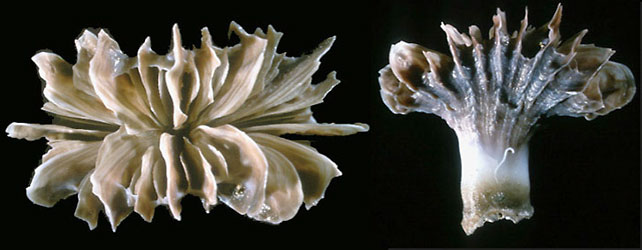
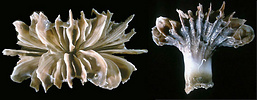


 Go to quick links
Go to quick search
Go to navigation for this section of the ToL site
Go to detailed links for the ToL site
Go to quick links
Go to quick search
Go to navigation for this section of the ToL site
Go to detailed links for the ToL site